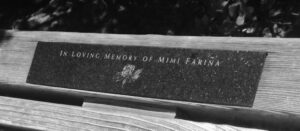From the 60’s to the ‘9ers with David Harris
by J.Macon King
David Harris, war activist, author, journalist, artist, died from lung cancer at his home in Mill Valley, CA on February 6, 2023, at the age of 76. This interview originally appeared in Mill Valley Literary Review Summer 2014 issue.
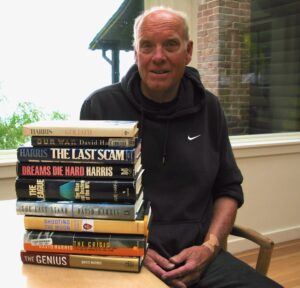
Davis Harris wrote for Rolling Stone Magazine during its original years in San Francisco (folded with no staples), The New York Times, and penned twelve non-fiction books covering heavyweight subjects such as the Iran hostage crisis in The Crisis, the NFL in The League, the timber takeover in The Last Stand, and how America outrageously arrested a foreign leader, Noriega, in Shooting the Moon.
A counter-culture icon, Harris’s friends and acquaintances included Hunter Thompson, Tom Hayden, Joe Eszterhas, Jan Wenner, Daniel Ellsberg, Ron Kovic (Born on the Fourth of July), and Mimi Fariña. He spent time with or interviewed a diverse group as the likes of the Beatles, Neal Cassady, Bill Walsh, Pete Rozelle, and CBS founder William S. Paley.
An interview with David Harris is like a condensed course in America’s social and cultural history of later 20th century. David Harris was more than a Vietnam protestor. He was an organizer and a man who embodied the activist protest movement. Instead of draft-dodging to Canada like many young men, Harris would go to prison for the cause. He captured the heart, and soon the hand, of “The Queen of the Scene” —folk singer Joan Baez. The Joan Baez, who had a music and media-filled romance with Bob Dylan and later was pursued by Steve Jobs. At the Woodstock Festival, Baez, pregnant with Harris’s child, prefaced the “organizing” song “Joe Hill” with reference to Harris’s recent felony imprisonment for refusing military induction and reporting that he already had organized a hunger strike.
David Harris grew up in California’s Central Valley, Fresno, as a normal lad, whose father was a G.I. Bill lawyer. Harris was a high school football player, Fresno High’s “Boy of the Year” who went on to Stanford Honors Program and Student Body President. But Harris suddenly took a “left turn.” Harris traveled to Birmingham and soon found himself at forefront of the civil rights and Vietnam resistance movement. His role came with a price. Imprisoned for almost two years, including months in solitary, his first book was published.
David married Joan Baez in the prison yard—which made the cover of LOOK magazine. In the seventies, Harris and friend Tom Hayden ran for political office—Harris nominated for Congress, but lost to the incumbent. Hayden lost a run for the Senate, but eventually was elected to the State Legislature.
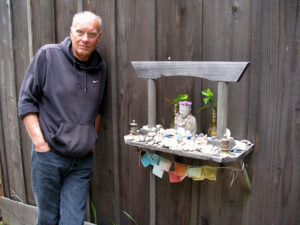
David invited me to his Mill Valley, CA hilltop home, built in 1932 and originally part of a large ranch. The bunkhouse was incorporated into the rambling house and the authentic split-log siding gives the place a rustic lodge look. The adjacent eucalyptus-ridged open space and the five-foot thick redwood tree jutting through his deck, complete the mountainside ranch feeling.
David, tall and loose-limbed, looks good at 68—relaxed, confident, and gracious. He exhibited none of the anxiety interview subjects often have of “the press.” He has been press himself.
Harris’s foyer is filled with David’s original art work, including what became the album cover for Joan Baez’s album Blessed are… . Modernized inside with rooms ranging from arts and crafts to 70s-retreat-rustic décor, this has been home for Harris since 1984. He shares the
residence with his third wife, physician Cheri Forrester. Touring from the kitchen to his downstairs den’s overflowing bookshelves, to the decks and redwood tree-graced estate, I began the interview with…
JMK: The Genius: How Bill Walsh Reinvented Football and Created an NFL Dynasty. David, a premise of your book is that rallying around Walsh’s revamped Forty Niners, brought San Francisco out of its post Moscone-Milk assassinations and Jonestown massacre slump.
HARRIS: Yes. San Francisco was at its nadir, and Walsh gave the City another way to see itself. It also marked the transition to Silicon Valley’s rise and the Bay Area’s re-imaging.
JMK: I read David Talbot’s recent Season of the Witch: Enchantment, Terror and Deliverance in the City of Love which outlined how bleak and scary events and politics were in San Francisco’s late 60s and seventies.
HARRIS: I know David.
JMK: There had been, Patty Hearst, the SLA and Peoples Temple (which your late wife Lacey Fosburgh covered for The Times), the Zebra murders, the Zodiac Killer, Moscone-Milk assassinations —I mean, back to back, San Francisco went through some really dark crazy times. I was living in the City for much of that. Then of course, internationally: the Iran hostage ordeal, boycotting the Russian Olympics, Afghanistan.
Suddenly—the Niners. I had never been into football at all, and by chance in 1982 I walked into this crowded corner bar on Haight Street, and I saw “The Catch.” Then and there I caught (ha) “Niner Fever” and became an instant Niner fan. Before your book, The Genius, I hadn’t really thought of it, but Bill Walsh did save San Francisco.
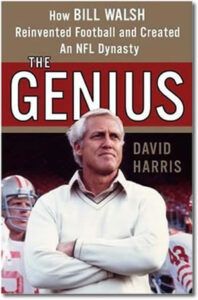
HARRIS: You know, I played O-line and offensive back football at Fresno High. I came to Stanford with the idea of being a walk-on (try out for the team). I get my equipment and go in the locker room and I see three guys that are bigger than me and taller than me. They said they were quarterbacks. I walked right back out. That was when Bill Walsh was coaching Stanford, so I missed that experience. But I made up for it by writing the book.
JMK: You also missed out on elected office experience, when your bid for Congress failed. You regret that?
HARRIS: No. It was for the best. I realized that I did not want to be a white-shoed, palm- slapping politician.
JMK: Let’s play “name association” about some of the famous people you knew. The star of Kerouac’s books—Neal Cassady.
HARRIS: Neal showed up on our doorstep in Menlo Park, after his Ken Kesey bus adventures. He was all jacked up. Neal was a crazy m…..fucker.
JMK: (laughs) Can I quote you? How was it working with Hunter S. Thompson?
HARRIS: I made a lot of money on football bets with Hunter. To his credit, he always paid me off. (smiles)
JMK: Well, what a nice young man! Now give me the dirt.
HARRIS: Hunter would just roll into the Stone and just take over Jann’s office. He’d barricade himself in, drinking and doing drugs. Hunter had Jann somehow under his spell. I didn’t get it. Jann would give Hunter these plum assignments—like the Fall of Saigon, an assignment that the rest of us would die for, literally, and off Hunter would go, and somehow, he missed the event! I mean, how do you miss the Fall of Saigon?!
JMK: Maybe the sound of all those helicopters lulled him to sleep?
HARRIS: Then, Hunter was assigned the Ali-Foreman fight.
JMK: “The Rumble in the Jungle.”
HARRIS: So, Rolling Stone flies Hunter to the Congo—and—he gets drunk and—he misses the fight! Hunter had to fly up to London and arrange to watch it on tape, just so he could file his report on the “Greatest Sporting Event of the Century.”*
JMK: So, Hunter Thompson was…
HARRIS: He was a crazy fucker.
(both laugh)
HARRIS: But, somehow Hunter, being Hunter, got away with it, and became a big celebrity for it. He did write two really, really great books.
JMK: As a motorcycle rider I’m picking one as Hell’s Angels.
HARRIS: No. No. The Fear and Loathing books.
JMK: OK, you’re right. You also worked with Joe Eszterhas?
HARRIS: Yes. Joe was my editor at the Stone before he became the million-dollar screenwriter.
JMK: Basic Instinct—big social impact in a number of ways. Eszterhas lived over in Tiburon for a while.
HARRIS: Right. Joe was a nice guy, but—not much of an editor.
JMK: Rolling Stone was a tremendous influence and in many ways, the voice for our generation. You were part of that. Why did you leave?
HARRIS: I left the Stone when the editing became more heavy-handed. When your story got stuffed to a certain editor, we writers would go, “Oh, shit.”
JMK: I just re-watched Cameron Crowe’s Almost Famous, and the late Philip Seymour Hoffman, as Cream magazine’s editor, gave a great warning line to the kid-journalist (based on Crowe, of course) about Rolling Stone doing that.
HARRIS: Crowe would know, as he was there. It was true. You knew it would just be
ruined. Arthur Gelb, The New York Times Editor said “David, come work for The Times.” I
thought, if you’re going to work for a paper, The Times is the one. Arthur was a great editor, he developed the sections of The Times that they still use today.
JMK: J.D. Salinger?
HARRIS: I didn’t know him. But my late wife, Lacey Fosburgh, who I met at The New York Times, was not only one of the few, but the last person to get an interview with Salinger. We were in our kitchen in Menlo Park, and the phone rang. She picks up and a voice says, “This is a man called Salinger.” Lacey about dropped the phone and I scramble around trying to find something to write with. She’s writing on every scrap of paper we can find. The story was published as front-page news in The Times Magazine in ’74.** I am interviewed in the recent Shane Salerno Salinger documentary about that event.
JMK: Joyce Maynard, another Mill Valley resident (but I heard she’s moving to East Bay), had a long interview in the documentary also.
HARRIS: She lived with the guy. Yes, well… kiss and tell.
JMK: Speaking of which… Joan Baez, what was she like back when you met her?
HARRIS: Joan was the Queen of the Scene. Gorgeous, talented, charismatic. The first time I met her, I thought, Whoa— too much celebrity. The second time, that flip-flopped and I obviously changed my mind.
 Joan Baez & Harris, Look magazine cover: “A family kept apart by conscience.” May 1970.
Joan Baez & Harris, Look magazine cover: “A family kept apart by conscience.” May 1970.
JMK: Can you sum up the sixties for us? What was it really like on the front lines?

HARRIS: A great time to be alive. To be 19, 20, 21 and be at The Center of the Universe. That’s what it felt like. As long as you could take the risk.
JMK: Addiction? Arrest? Too much freedom?
HARRIS: The whole thing was risky business. We were breaking out in all fronts. This was all new territory.
JMK: You wrote one novel, The Last Scam.
HARRIS: It grew out of my Times Magazine cover story about my 1978 trip to Mexico with a dope smuggler. We spent months in Oaxaca. The book was published in ’81.
JMK: I remember Oaxacan in the late 70s. Big long buds. Good stuff.
HARRIS: Yes, it was. It was seedless, before sinsemilla became the norm.
JMK: Maybe I got some of your partner’s batch! Talk about risky business. That was ballsy, going down in there and documenting smuggling out kilos of Oaxacan. A lot to go wrong there.
HARRIS: My publisher decided to call it a “non-fiction” novel.
JMK: Sounds like hedging their bets, legally. I tried to find that book but it is O.P.
HARRIS: The Last Scam was released and made the front cover of the “Pink section” (San Francisco Chronicle’s A&E guide). There was a grand total of three copies in all the bookstores in San Francisco!
JMK: Great, huh?
HARRIS: Publishing!
JMK: There is only one other book I know like your The Last Scam —Weed: Adventures of a Dope Smuggler, by Jerry Kamstra, whom I’ve met and chatted with.
HARRIS: Yes, right. I think I have that somewhere around here.
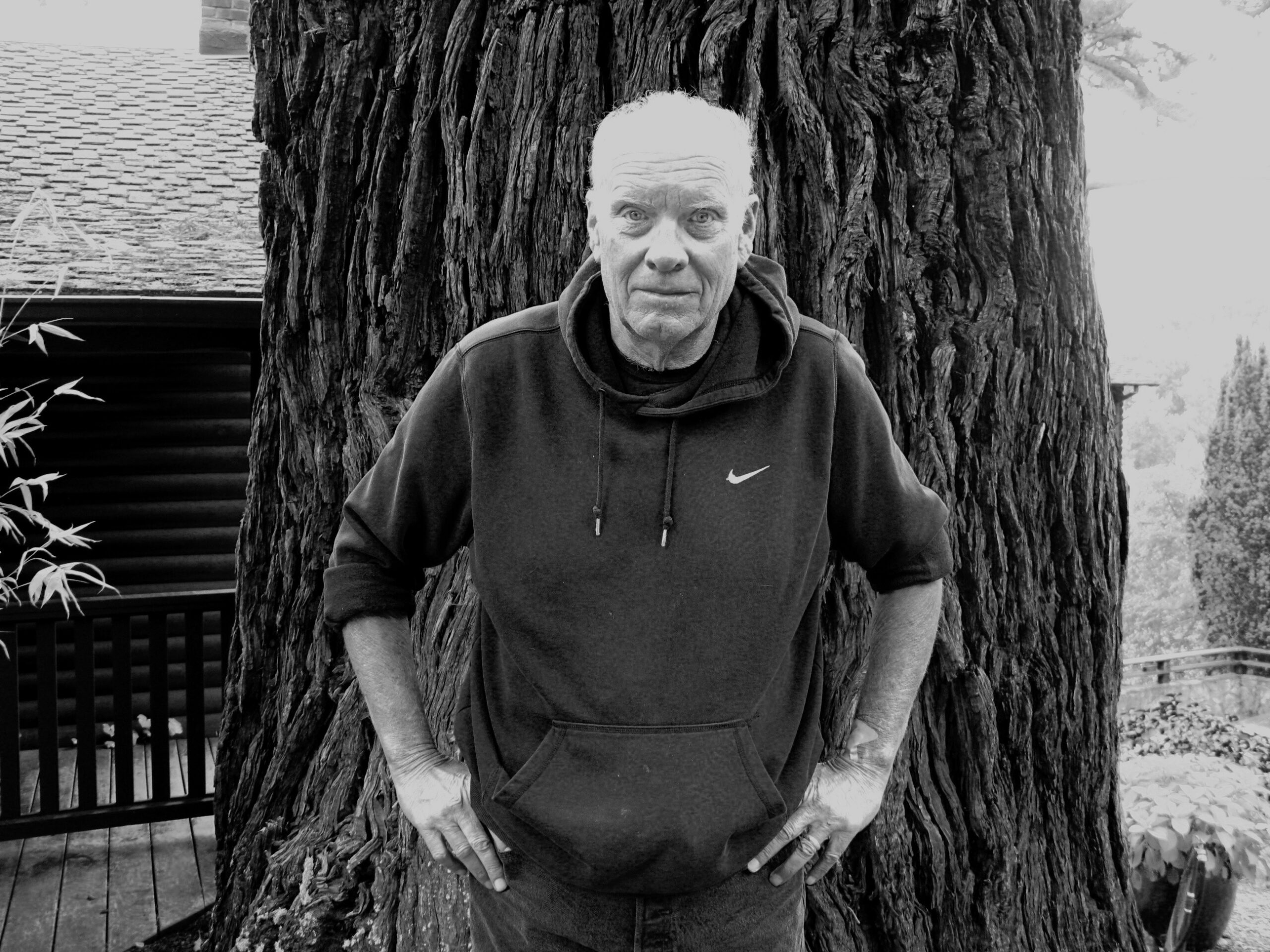 Harris with one of his redwood trees in front garden. (Photo: King)
Harris with one of his redwood trees in front garden. (Photo: King)JMK: I can only imagine the tremendous amount of obsessive research that goes into one of your many non-fiction books. Writing a novel, at least a good novel, a writer reaches a point that the characters take on a life of their own, and the plot can unfold naturally. At what point in a complex non-fiction book can you tell if it is working or not?
HARRIS: For me, I can tell in my research. My routine is I would spend the first year or two researching. I would frame out the book. I could tell when I did that framing if the book was going to work. If it didn’t seem to be working, I would do more research. I would master my material and I’d only start writing when I had the back broken.
JMK: Tell us about the “one that got away.”
HARRIS: The Paley bio. I almost had a breakdown. Seriously, it almost killed me. William S. Paley was huge—he founded CBS and 20th Century broadcasting. Amazing man—he had an enormous private art collection. In his entryway—there was “Boy Leading a Horse.” Picasso. Look at this. (Harris shows the painting from “The William S. Paley Collection” book).

- Courtesy: pablopicasso.org
I spent three years researching Paley. I had papers eight feet high all across my room. Our contract was that Paley could not change anything for the book. But he reserved the right to pull the plug. He started losing his mind a bit, dementia I guess. His lawyer took over. His lawyer was Arthur Liman. He was tough. He was the chief consul for the Iran-Contra Congressional hearings who went after Oliver North.
Liman asked me to take out the sex. Now, Paley loved the women. He had a lot of glamorous women, like Gretta Garbo, Louise Brooks. I said, No, I can’t take that out. Liman pulled the plug. He sent over a truck and took away my eight-foot stacks of researched documents. That was it. All that time and work gone.***
JMK: The late Don Carpenter, of Mill Valley—his last novel, Fridays at Enrico’s was just released, about the literary scene in the Bay Area; North Beach of course. Did you know Don?
HARRIS: No, I wasn’t really part of a “literary scene.” If anything, I hung out with reporters and journalists. But I really just researched and wrote. In North Beach, when Lacey and I lived at her Telegraph Hill triplex in the seventies, we had separate writing spaces on separate floors, and we just stayed in and wrote.
JMK: So, what’s in the works now?
HARRIS: I have a new novel.**** It’s looking for a home. The story is set in the Central Valley in the late 70s. Even with my publishing record, good reviews, admittedly medium sales, it is not easy. You have a generation coming up that thinks Twitter is literature.
END
R.I.P David…
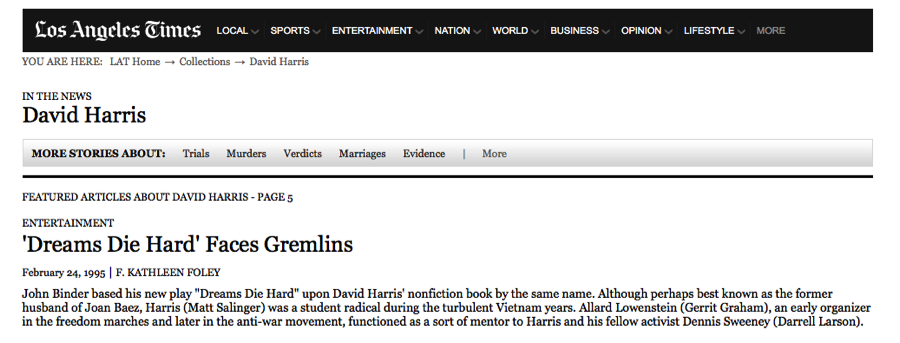
Notes:
*Norman Mailer and George Plimpton did manage to cover the boxing event, later writing the books, respectively The Fight, and Shadow Box.
** See Fosburgh’s 1974 interview “J.D. Salinger Speaks About his Silence” http://www.nytimes.com/books/98/09/13/specials/salinger-speaks.html
Salinger’s first interview was oddly, but characteristically, with a 16-year old high school girl.
Fosburgh covered the Patty Hearst kidnapping as well as Jim Jones\Peoples Temple, wrote the bestseller book, Closing Time, on the so-called Looking for Mr. Goodbar Murders, which received praise from the hyper-critical Truman Capote. Fosburgh was also a novelist.
Shane Salerno’s Salinger film was one of the top-ten highest-grossing documentaries of 2013. (His screenplays include Avatar: The Way of Water, co-writer of Armageddon.)
*** Paley, despite his lawyer’s concern for keeping the womanizing secret, was included in a list of the ten most eligible bachelors compiled by Cosmopolitan magazine 1985. He was age 84!
****David Harris’s unpublished novel: A Desperado’s Downhome Melodrama, Love Story and Outlaw Shoot-em-up, Writ In the Vernacular and Best Read Out Loud. Set in the Central Valley in the late 1970s, it tells the story of an outlaw’s return to his hometown after ten years outside the law in Mexico because his mother is dying, and what happens when he steps back into the world of lowlifes and gangsters he left behind.
For more info see the Harris website http://davidharriswriter.com/
SIDEBAR: David’s circle, through Joan Baez, included Joan’s late sister, musician activist Mimi Fariña, who founded Marin County, CA based non-profit Bread and Roses, and Mimi’s husband folksinger Richard Fariña. Multi-talented Richard Fariña penned the counterculture classic picaresque novel, Been Down So Long It Looks Like Up to Me. At age 29, Richard was tragically killed on a friend’s Harley, speeding through a fence on Carmel Valley Road, Carmel, CA. It was just two days after the publication of the book and following a book-signing event in Carmel. To triple the tragedy—it was his wife Mimi’s 21st birthday.
Thomas Pynchon later dedicated his sci-fi classic Gravity’s Rainbow to Fariña, and Rock and Roll historian Ed Ward, proclaimed, “If Richard had survived that motorcycle accident, he would have easily given Dylan a run for his money.” Joan Baez’s song, “Sweet Sir Gallahad” commemorates Fariña’s death and Mimi’s grief.
